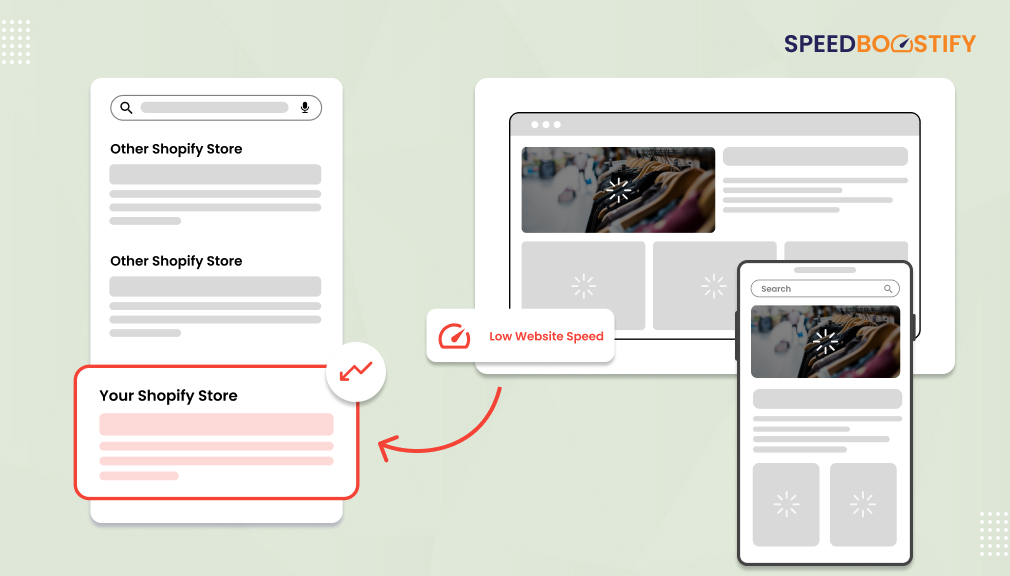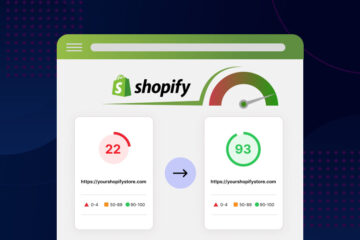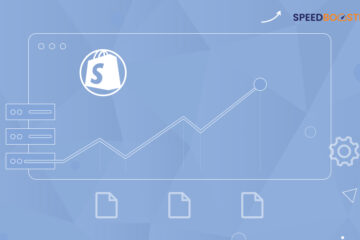In the fast-paced world of e-commerce, every second is important. Yet even though you as a Shopify store owner should already be aware of how crucial search engine optimization (SEO) is to get your website noticed, there is another major consideration that often goes overlooked: load times. This comprehensive guide will help you to understand how the speed at which your site loads affects both its SEO ranking and organic traffic levels on Shopify and suggest practical ways to speed up your Shopify store to maximize search engine rankings for your store as well as attract more visitors.
Understanding the Impact of Site Speed on SEO
For a Shopify store, “site speed” means the rate at which its pages are flowing and filled up by your customers in their web browsers. In addition to harming the user experience, slow website speed also damages search engines’ respect for you. Google and other search engines discriminate using rivalry between sites when it comes to speed, design, and layout features. Fast sites rank higher because they improve users’ experience.
Google tells us site speed matters. If your website downloads quickly, thus trouncing the output of competitors who deliver yesterday’s news to today’s papers, then perhaps you ought to expect a high ranking in searches. Slow-loading sites, on the other hand, may be penalized by Google search engine algorithms which lower their rankings radically or remove them from view altogether.
Other search engines also take site speed into account when ranking websites. Bing, for example, has publicly stated that load time is one of the parameters in its algorithms for determining where your pages will be ranked on search results pages.
The Connection Between Site Speed and User Experience
How fast your site runs has a direct impact on user experience, and is one of the key factors in SEO. Studies have revealed that users will more readily leave a website that takes so long for itself to load with this win-at-the-expense-of-others way of doing things yielding fewer rewards for visitors and search engines Slow-loading webpages annoy users.
It also makes them less likely to spend time browsing your website or buying anything Conversely Fast-loading webpages mean for visitors especially if there are pictures involved data downloaded and presented to their computers quickly enough that they can see everything well on screen before being forced away from one page or another.
You are trying to promote a product that may earn profit while positioning it as an important new development; however, in neither case is the ad desirable to your potential customer.
How Site Speed Influences Organic Traffic
If your site is slow, then not only will it earn lower search rankings in SERP to organic traffic will also decrease. Pages that load quickly will likely be crawled and indexed by search engine bots, along with the words stemming from Adamot’s excellent article leads. Faster page load times are likely to attract search bots, which in turn will bring better search engine results.
If ever your Shopify store rank gets higher than others as a result of speed, you can expect organic traffic to increase as well. As a result, this increased visibility can lead to faster turnover for your online store. More clicks, more visits, and ultimately more sales.
Key Factors Impacting Site Speed on Shopify:
Several factors can impact the speed of your Shopify store, including:
Image optimization: A page that relies on oversized images to attract viewers will load slowly. Employing compression techniques and utilizing suitable file formats will allow you to reduce the size of your image files without sacrificing either quality or load time.
Code optimization: To reduce the server requests and improve load times it is a good idea to minimize and compress your CSS, JavaScript, and HTML files.
App usage: The more apps you install onto your Shopify store, the larger will be the code base and complexity that can slow performance. Whenever possible, choose lightweight and well-optimized apps.
Hosting provider: Choose an established hosting service with fast servers and scalable infrastructure to ensure that your website can always offer good performance even if a great deal of traffic is coming through the site all at once.
Actionable Strategies for Speed Optimization
Certainly! Here are some actionable strategies for speed optimization specifically tailored to Shopify stores:
- Optimize Images:
- Use Shopify’s built-in image optimization tools or third-party programs to compress and resize images without losing quality.
- Convert images to the most efficient file format (e.g., JPEG for photographs, PNG for graphics with transparency) to reduce file sizes.
- Implement lazy loading to defer the loading of off-screen images until they are needed, improving initial page load times.
- Minify and Combine Files:
- Minify CSS, JavaScript, and HTML files to remove unnecessary characters like whitespace and comments, reducing file sizes.
- Combine multiple CSS and JavaScript files into a single file to minimize the number of HTTP requests required to load a page.
- Reduce App Usage:
- Limit the number of apps installed on your Shopify store, as each app adds additional code and functionality that can impact performance.
- Regularly review and uninstall apps that are no longer necessary or that duplicate functionality provided by other apps.
- Optimize Theme Code:
- Review and optimize your Shopify theme code to remove unused or redundant code and improve performance.
- Consider using a lightweight and well-optimized theme designed for speed, or work with a developer to customize your existing theme for better performance.
- Enable Browser Caching:
- Leverage browser caching to instruct visitors’ browsers to store static assets (e.g., images, CSS, JavaScript) locally, reducing server load and improving load times for returning visitors.
- Configure caching headers to specify how long assets should be cached and when they should expire.
- Monitor Performance Regularly:
- Use tools like Google PageSpeed Insights, GTmetrix, or Shopify’s built-in performance dashboard to monitor your store’s performance regularly.
- Set up alerts or notifications to be notified of performance issues or unexpected changes that may affect speed and take action promptly.
Conclusion
In this competitive e-commerce age, site speed is now a must; it’s not just a good idea for your customers, but also an important factor in search engine optimization and attracting organic traffic. Start focusing some optimization efforts on the speed of your store through Shopify. Improving search engine position, making user experiences richer, and grabbing more organic traffic will help you turn visitors into paying customers and yield higher conversions and revenue. Start using these schemes today and you’ll get the benefits of a faster website that’s better optimized in no time.




